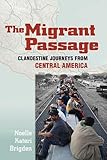The Migrant Passage : Clandestine Journeys from Central America / Noelle Kateri Brigden.
Material type: TextPublisher: Ithaca, NY : Cornell University Press, [2018]Copyright date: ©2018Description: 1 online resource (264 p.) : 10 b&w halftones, 1 mapContent type:
TextPublisher: Ithaca, NY : Cornell University Press, [2018]Copyright date: ©2018Description: 1 online resource (264 p.) : 10 b&w halftones, 1 mapContent type: - 9781501730566
- Central Americans -- Violence against -- Mexico
- Central Americans -- Mexico -- Social conditions
- Human smuggling -- Mexico
- Illegal aliens -- Violence against -- Mexico
- Illegal aliens -- Mexico -- Social conditions
- History
- Latin American & Caribbean Studies
- Sociology & Social Science
- SOCIAL SCIENCE / Emigration & Immigration
- Migration, borders, Central America & Mexico, Transnationalism, Ethnography
- 304.809728 23
- JV7412
- online - DeGruyter
| Item type | Current library | Call number | URL | Status | Notes | Barcode | |
|---|---|---|---|---|---|---|---|
 eBook
eBook
|
Biblioteca "Angelicum" Pont. Univ. S.Tommaso d'Aquino Nuvola online | online - DeGruyter (Browse shelf(Opens below)) | Online access | Not for loan (Accesso limitato) | Accesso per gli utenti autorizzati / Access for authorized users | (dgr)9781501730566 |
Frontmatter -- Contents -- ACT 1. Exposition -- Chapter 1. The Opening Scene: A Journey Begins -- Chapter 2. The Plot: Migration Stories Take Shape -- Chapter 3. The Cast of Characters: Actors and Their Relationships en Route -- ACT 2. Rising Action -- Chapter 4. The Performance: Migrant Scripts and Roles -- Chapter 5. The Stage: Mobile Images and Props -- ACT 3. Climax -- Chapter 6. A Tragedy: Conclusions and Implications -- Acknowledgments -- Notes -- References -- Index
restricted access online access with authorization star
http://purl.org/coar/access_right/c_16ec
At the crossroads between international relations and anthropology, The Migrant Passage analyzes how people from El Salvador, Honduras, and Guatemala navigate the dangerous and uncertain clandestine journey across Mexico to the United States. However much advance planning they do, they survive the journey through improvisation. Central American migrants improvise upon social roles and physical objects, leveraging them for new purposes along the way. Over time, the accumulation of individual journeys has cut a path across the socioeconomic and political landscape of Mexico, generating a social and material infrastructure that guides future passages and complicates borders.Tracing the survival strategies of migrants during the journey to the North, The Migrant Passage shows how their mobility reshapes the social landscape of Mexico, and the book explores the implications for the future of sovereignty and the nation-state. To trace the continuous renewal of the transit corridor, Noelle Brigden draws upon over two years of in-depth, multi-sited ethnographic fieldwork along human smuggling routes from Central America across Mexico and into the United States. In so doing, she shows the value of disciplinary and methodological border crossing between international relations and anthropology, to understand the relationships between human security, international borders, and clandestine transnationalism.
Mode of access: Internet via World Wide Web.
In English.
Description based on online resource; title from PDF title page (publisher's Web site, viewed 26. Apr 2024)


